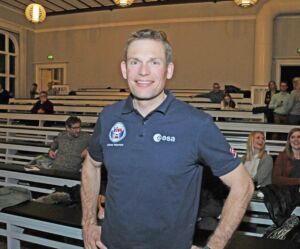News
If we believed Andreas, they could put a Dane on the Moon
This article is more than 2 years old.
Denmark has a fighting chance of putting somebody on the lunar landscape, but the decision will most likely be political, concedes its first man in space

Lunar longings (photo: Hasse Ferrold)
Few who watched the Moon Landings in 1969 would have guessed that nearly 55 years later the world would still be waiting for a second nation to put astronauts on the lunar surface.
And while Denmark, which in 2015 became the 39th of the 44 nations to put somebody in space, won’t necessarily become the second, it is in the hunt to put an astronaut on the Moon within the next decade.
Andreas Mogensen, the Dane who put his country on the space map eight years ago, is hopeful it will be himself.
READ MORE: Andreas becomes the first Dane in space
Dannebrog on the Moon?
Speaking to DR ahead of his six-month mission aboard the International Space Station (ISS), which begins in August and will involve him spending considerably more time than his previous 10-day visit, Mogensen suggests Europe might be offered three seats on NASA lunar missions in the next five to ten years.
“We will probably get three European seats on NASA’s lunar mission,” he revealed. Mogensen concedes the final decision on which European countries are selected will be political, but he retains hope.
“I would really like to go to the Moon, so I will cross my fingers and work for it. But the competition is fierce,” he said.
The omens are good, as on his mission Mogensen will become the first non-American astronaut to pilot the SpaceX vessel Dragon.
Still plenty of time to achieve his goal
Mogensen turns 50 in late 2026, but his age shouldn’t be restrictive, as the average age of debutant space shuttle astronauts has jumped from the late 30s in the mid-1990s to the mid-40s today.
The average age of space shuttle crew members is 46.7 – a fraction over Mogensen’s age today – up from 40.7 in 1995.
In one case, a 77-year-old went into space, although that was legend John Glenn, the first American to orbit the Earth – back in 1962.










































